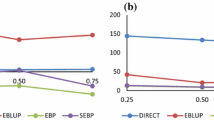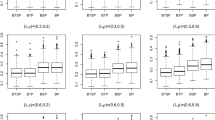Abstract
Small area estimators are often based on linear mixed models under the assumption that relationships among variables are stationary across the area of interest (Fay–Herriot models). This hypothesis is patently violated when the population is divided into heterogeneous latent subgroups. In this paper we propose a local Fay–Herriot model assisted by a Simulated Annealing algorithm to identify the latent subgroups of small areas. The value minimized through the Simulated Annealing algorithm is the sum of the estimated mean squared error (MSE) of the small area estimates. The technique is employed for small area estimates of erosion on agricultural land within the Rathbun Lake Watershed (IA, USA). The results are promising and show that introducing local stationarity in a small area model may lead to useful improvements in the performance of the estimators.
Similar content being viewed by others
References
Ben-Ameur W (2004) Computing the initial temperature of simulated annealing. Comput Optim Appl 29: 369–385
Benedetti R, Catenaro R, Postiglione P (2006) Local stationarity of spatial regression models. In: Spatial data methods for environmental and ecological processes
Fay R, Herriot R (1979) Estimates of income for small places: an application of james-stein procedures to census data. J Am Stat Assoc 74: 269–277
Fouskakis D, Draper D (2002) Stochastic optimization: a review. Int Stat Rev 70: 315–349
Geman D, Geman S (1984) Stochastic relaxation, gibbs distributions and bayesian restoration of images. IEEE PAMI 6: 721–741
Geman D, Geman S, Graffigne C, Dong P (1990) Boundary detection by constrained optimization. IEEE PAMI 12: 609–628
Giusti C, Marchetti S, Pratesi M, Salvati N (2012) Semiparametric fay? Herriot model using penalized splines. J Indian Soc Agric Stat 66: 1–14
Kirkpatrick S, Gelatt C, Vecchi M (1983) Optimization by simulated annealing. Science 220: 671–680
Opsomer JD, Miller CP (2005) Selecting the amount of smoothing in nonparametric regression estimation for complex surveys. J Nonparametr Stat 17: 593–611
Opsomer JD, Botts C, Kim JY (2003) Small area estimation in watershed erosion assessment survey. J Agric Biol Enviro Stat 2: 139–152
Páez A, Uchida T, Miyamoto K (2002) A general framework for estimation and inference of geographically weighted regression models: 1. Location-specific kernel bandwidths and a test for locational heterogeneity. Enviro Plan A 34: 733–754
Páez A, Uchida T, Miyamoto K (2002) A general framework for estimation and inference of geographically weighted regression models: 2. Spatial association and model specification test. Environ Plan A 34: 883–904
Petrucci A, Salvati N (2006) Small area estimation for spatial correlation in watershed erosion assessment. J Agric Biol Environ Stat 11: 169–182
Prasad N, Rao JN (1990) The estimation of the mean squared error of small-area estimators. J Am Stat Assoc 85: 163–171
Pratesi M, Salvati N (2008) Small area estimation: the eblup estimator based on spatially correlated random area effects. Stat Methods Appl 17: 114–131
Pratesi M, Salvati N (2009) Small area estimation in the presence of correlated random area effects. J Off Stat 25: 37–53
Rao J (2003) Small area estimation. Wiley, London
Sebastiani M (2003) Markov random-field models for estimating local labour markets. Appl Stat 52: 201–211
Singh B, Shukla K, Kundu D (2005) Spatial-temporal models in small area estimation. Surv Methodol 31: 183–195
Stander J, Silverman BW (1994) Temperature schedules for simulated annealing. Stat Comput 4: 21–32
Strenski PN, Kirkpatrick S (1991) Analysis of finite length annealing schedules. Algorithmica 6: 346–366
Tibshirani R, Walter G, Hastie T (2001) Estimating the number of clusters in a dataset via the gap statistic. J R Stat Soc B 32: 411–423
van Laarhoven PJM, Aarts EHL (1987) Simulated annealing: theory and applications. D. Reidel, Dordrecht
Author information
Authors and Affiliations
Corresponding author
Rights and permissions
About this article
Cite this article
Benedetti, R., Pratesi, M. & Salvati, N. Local stationarity in small area estimation models. Stat Methods Appl 22, 81–95 (2013). https://doi.org/10.1007/s10260-012-0208-1
Accepted:
Published:
Issue Date:
DOI: https://doi.org/10.1007/s10260-012-0208-1




